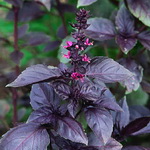| Common Name: |
Ocimum 'Dark Opal' |
| Other Names: |
Ocimum 'African Blue' |
| Botanical Name: |
Ocimum kailimandscharicum x O. basilicum |
| Genus: |
Ocimum |
| Family: |
Lamiaceae |
| Cultivation: |
Rich, light, well-drained to dry soil in sun, pH5-8. Pinch out growing tips to encourage bushiness and delay flowering. Ocimum x. citriodorum dislikes transplanting so is best sown in situ. Slugs, aphids, whitefly, spider mites, and Botrytis may attack plants. Basil is often used in companion planting because it is said to repel aphids, asparagus beetles, mites, and tomato hornworms, and to slow the growth of milkweed bugs. |
| Position: |
Basils require a protected, warm, sunny site with a well-drained soil. |
| Propagation: |
By seed sown in spring at 13°C (55°F); by softwood cuttings in spring (perennials and shrubs).
With the exception of the perennial basils, basils are generally treated as annuals and propagated from seed. Do not plant seeds directly in the garden until the soil warms. For an early start, plant into seed trays kept in a warm and protected environment. Grow seedlings of smaller varieties in pots or spaced about 1ft (30cm) apart, larger bush types about 1.5ft (45cm) apart. Basils cross very readily between varieties, so seeds saved in a mixed planting will not grow true to type in the following year unless you prevent cross-pollination by bees. You can also take cuttings from side shoots. |
| Maintenance: |
Water regularly. Being a tropical plant, basils grow rapidly at temperatures in excess of 60°F (16°C) and is frost-sensitive. Pinch out flower heads to promote bushy plant growth and to prolong the plant's productive life. |
| Pests and Diseases: |
A fungal disease called fusarium wilt can attack plants, causing sudden wilting. Remove and destroy affected plants (do not compost them), and do not replant basil in the comtaminated soil. Consider planting basil among other plants, rather than en masse. They make a fashionable additive to the ornamental garden. |
| Harvest: |
Whole plants (O. americanum, O. basilicum, O. gratissimum, O. tenuiflorum) are cut just before flowering begins and dried or distilled for oil. Leaves are picked during the growing season and used fresh or juiced, or dried for infusions and decoctions. Ocimum tenuiflorum is prepared as powder adn medicated ghee. Seeds (O. americanum, O. basilicum, O. tenuiflorum) are collected when ripe and dried for decoctions. Roots are harvested and dried for decoctions.
Harvest mature leaves and flower spikes for fresh use at any time. To dry the leaves, cut bushes at the base and hang out of direct light, then store in an airtight container in a cool place. |
| Height: |
60cm-1.5m (2-5ft) |
| Width: |
30cm-1m (1-3ft) |
| Hardiness: |
Z10 |
| History: |
Basil has both positive and negative associations that include love and fear, danger and protection, and life and death. The negative connotations probably come fomr the basil's Lating epithet basilicum, which links it to the basilisk, the mythical serpent with the deadly gaze. The ancient Greeks and Romans believed that uttering a curse when sowing basil would ensure its germination. |
| Parts Used: |
Leaves |
| Properties: |
An aromatic herb, with a balsam-camphor scent. |
| Home Uses: |
Basil is a natural disinfectant. Use the essential oil in combination with other antiseptic herbal oils to make disinfectant sprays for cleaning household surfaces. Plant basil in a pot close to the back door to deter flies. Cut a bunch of basil as an aromatic table centerpiece when you eat outdoors. The dried flower heads add a sweet and spicy note to potpourri. |
| Culinary Uses: |
Usable but inferior for flavoring or tea.
Basil is one of the great culinary herbs; different varieties are used extensively in both European and Asian cooking. If a recipe specifies simply "basil", sweet or common basil (Ocimum basilicum) is the type generally meant. Fresh sweet basil is highly aromatic, with a distinctive scent and flavor reminiscent of aniseed, and tends to be either loved or loathed. Dried basil tastes more of curry, and is a poor substitute for the fresh herb and should be avoided
Using a knife to cut basil can bruise and darken the leaves. For salads and pasta sauces where appearance matters, shred the leaves with your fingers. Young leaves have the best flavor, while old ones have a coarser, stronger taste.
In cooked dishes, basil quickly loses its aroma and the leaves tend to darken, so add it to give depth of flavor during cooking and then, for fragrance and visual appeal, stir in a little more must before serving. Tomato dishes, chicken, egg and rice dishes, spaghetti sauces, fish and vegetables - especially beans, capsicum and eggplants - all go well with basil. Basil is a good addition to stuffings. The most famous use of basil is in pesto (or pistou in French). Citrus-scented and spice-flavored varieties of basil work well in a range of Asian recipes. |
| Bibliography: |
Encyclopedia of Herbs by Deni Brown Copyright © 1995, 2001 Dorling Kindersley Limited. pp 290-291 |

